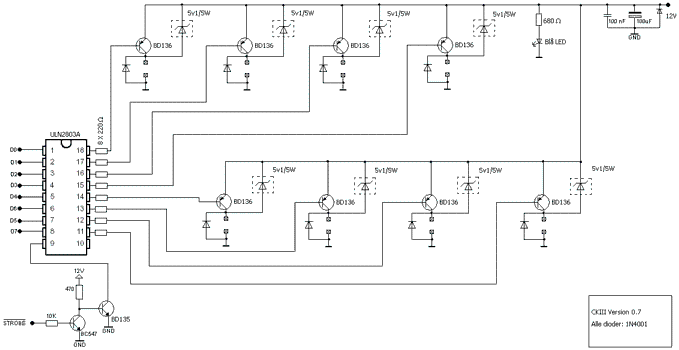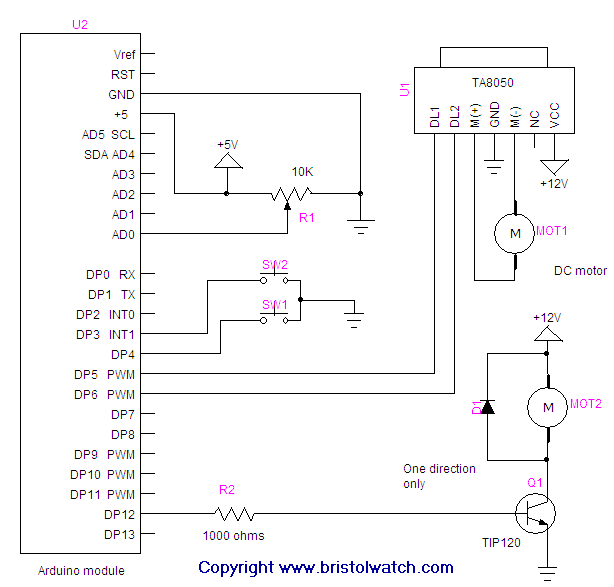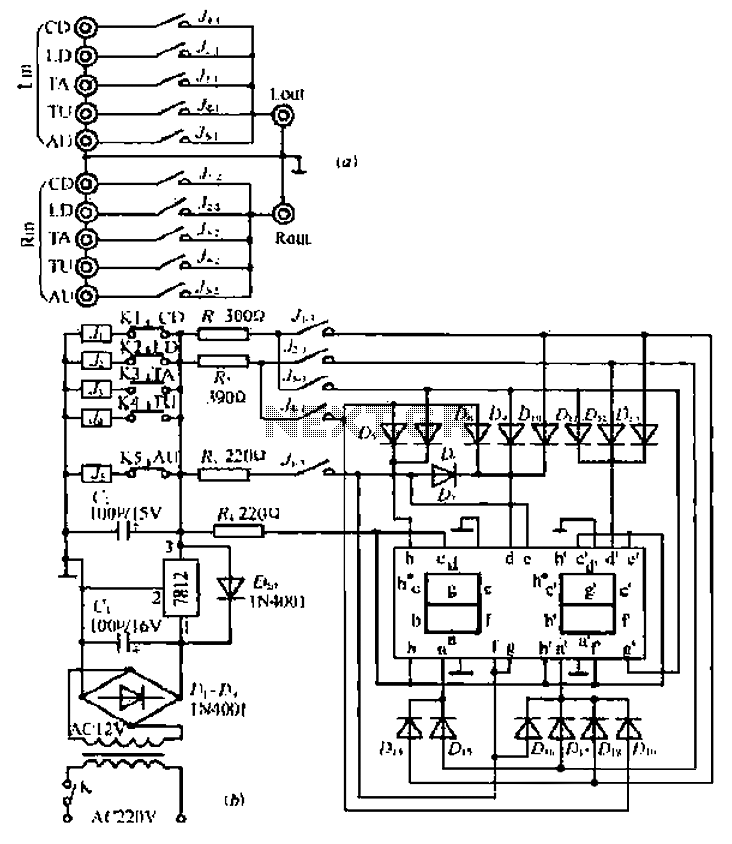
8 Channel software controlled fanbus with PWM

This article was previously published, but the intention is to spread the idea further, potentially inspiring new concepts. An improved version was being developed using an ULN2803A instead of multiple BC547B transistors and optional Zener diodes to ensure that the fans received power upon startup. However, the project was not completed due to a loss of interest from a collaborator. The software was enhanced independently, featuring improved fan control routines and speeds, command-line parameters for adjusting power levels during runtime, and a "KITT (Knight Rider)" running light functionality for the outputs, which appears visually appealing with eight connected LEDs. A Polish individual requested the command-line functionality, and after successful implementation, feedback indicated no reported bugs. However, thorough personal testing has not been conducted, although initial tests yielded positive results.
The project centers around a fan control system that utilizes an ULN2803A, a high-voltage, high-current Darlington transistor array, which serves as a replacement for multiple BC547B transistors. This change simplifies the circuit design while enhancing reliability and efficiency. The ULN2803A is capable of driving inductive loads, such as fans, and includes built-in flyback diodes that protect the circuit from voltage spikes when the fans are turned off.
The circuit design incorporates optional Zener diodes to stabilize the voltage supplied to the fans, ensuring consistent performance during power-on conditions. This feature is critical for applications where fan reliability is paramount, such as in cooling systems for electronics.
The software component of the project introduces several enhancements to the fan control logic, allowing for more flexible operation. The improved fan control routines enable dynamic adjustment of fan speeds based on temperature readings or other environmental factors, optimizing cooling efficiency. The command-line parameters provide users with the ability to modify power levels in real-time, facilitating tailored performance adjustments without the need for hardware modifications.
Additionally, the implementation of the "KITT" running light feature adds a visually engaging element to the project. This functionality utilizes a sequence of eight LEDs that can be programmed to light up in a pattern reminiscent of the iconic Knight Rider car, enhancing the aesthetic appeal of the system while also serving as an indicator of operational status.
Overall, this fan control project exemplifies a blend of hardware and software innovation, showcasing the potential for further development and refinement in electronic circuit design and control systems. The positive feedback from users indicates a successful implementation of the command-line functionality, pointing towards a solid foundation for future enhancements and applications in similar projects.This article was previously published at, but I`d like to spread the idea further, possibly sparking new ideas in some of you, so I`m releasing it here too. My old partner and I were working on an improved version, using an ULN2803A instead of the many BC547B`s and optional zener diodes to make sure the fans always got power from power-on, but h
e lost interest and so we never finished it. I did improve the software on my own, though: - improved fan control routines/speeds - command line parameters to adjust the power level during runtime - "KITT(Knight Rider)" running light functionality to the outputs, which looks pretty cool with 8 LED`s attached A Polish guy had asked me for the command-line functionality, and after getting it to work I let him play with the new program, and he hasn`t reported any bugs. I haven`t personally thoroughly tested it, though - but it has worked perfectly in my short-time tests.
🔗 External reference
The project centers around a fan control system that utilizes an ULN2803A, a high-voltage, high-current Darlington transistor array, which serves as a replacement for multiple BC547B transistors. This change simplifies the circuit design while enhancing reliability and efficiency. The ULN2803A is capable of driving inductive loads, such as fans, and includes built-in flyback diodes that protect the circuit from voltage spikes when the fans are turned off.
The circuit design incorporates optional Zener diodes to stabilize the voltage supplied to the fans, ensuring consistent performance during power-on conditions. This feature is critical for applications where fan reliability is paramount, such as in cooling systems for electronics.
The software component of the project introduces several enhancements to the fan control logic, allowing for more flexible operation. The improved fan control routines enable dynamic adjustment of fan speeds based on temperature readings or other environmental factors, optimizing cooling efficiency. The command-line parameters provide users with the ability to modify power levels in real-time, facilitating tailored performance adjustments without the need for hardware modifications.
Additionally, the implementation of the "KITT" running light feature adds a visually engaging element to the project. This functionality utilizes a sequence of eight LEDs that can be programmed to light up in a pattern reminiscent of the iconic Knight Rider car, enhancing the aesthetic appeal of the system while also serving as an indicator of operational status.
Overall, this fan control project exemplifies a blend of hardware and software innovation, showcasing the potential for further development and refinement in electronic circuit design and control systems. The positive feedback from users indicates a successful implementation of the command-line functionality, pointing towards a solid foundation for future enhancements and applications in similar projects.This article was previously published at, but I`d like to spread the idea further, possibly sparking new ideas in some of you, so I`m releasing it here too. My old partner and I were working on an improved version, using an ULN2803A instead of the many BC547B`s and optional zener diodes to make sure the fans always got power from power-on, but h
e lost interest and so we never finished it. I did improve the software on my own, though: - improved fan control routines/speeds - command line parameters to adjust the power level during runtime - "KITT(Knight Rider)" running light functionality to the outputs, which looks pretty cool with 8 LED`s attached A Polish guy had asked me for the command-line functionality, and after getting it to work I let him play with the new program, and he hasn`t reported any bugs. I haven`t personally thoroughly tested it, though - but it has worked perfectly in my short-time tests.
🔗 External reference





